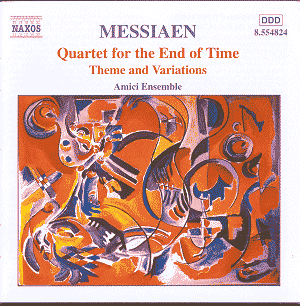Olivier MESSIAEN (1908-1992)
Quartet for End of Time
Theme and Variations*
 Amici Ensemble
Amici Ensemble
Joaquin Valdepeñas, clarinet; David Hetherington, cello;
Patricia Parr, piano*; Scott St John, violin*
Rec 15th-16th December 1999, River Run Centre, Guelph, Ontario, Canada
 NAXOS 8.554824
[56.48]
NAXOS 8.554824
[56.48]
Crotchet
AmazonUK
AmazonUS
Amazon
recommendations

The Quartet for the End of Time is both Messiaen's most significant
contribution to chamber music and one of the most significant musical products
of the Second World War. It was written while the composer was a prisoner-of-war
in Stalag 8A in Görlitz, Silesia, the particular instrumentation - piano,
violin, cello and clarinet - determined by these circumstances.
Messiaen confessed that 'only music made me survive the cruelty and horrors
of the camp'. It was there that the premiere took place in January 1941,
with the composer at the piano: 'Never has an audience listened to my music
with such rapt attention.'
The eight movements vary considerably in approach. Two are solos (one for
clarinet, the other for piano), while two others are duos (cello and piano,
violin and piano). The musical language is sometimes exploratory too, such
as when the first movement adopts a polyrhythmic style. All these things
make the music a special challenge to the performers, who need to pay particular
attention to demands of this complex score.
For example the fifth movement, a meditation entitled 'Hymns of Praise on
the Eternity of Jesus' must be played 'infinitely slowly' (as the metronome
mark confirms), and the style must be 'ecstatic, majestic, meditative and
very expressive'. It is clearly no easy task to at once achieve all these
demands, and to be frank, these performer's don't quite bring it off. The
reason is simply tempo, which is too flowing, not slow enough. Yet the music
does still have the ecstatic and expressive qualities Messiaen seeks, and
this is not least because it is so well played. But other performances, notably
that by Anner Bylsma and Vera Beths (Philips 446 578-2PM) are slower and
more rapt.
The Naxos recorded sound is excellent, with a natural perspective and atmosphere,
and an appropriate dynamic range. Dynamics count for a lot in this music
and the musicians and engineers make the most of this to fine effect. The
magical opening, with cello harmonics and hints of birdsong, sets the standard.
This is a sensitive performance, well worth hearing, and in the ensemble
movements, the rich quasi-orchestral passages are satisfying too.
There is an additional item in the form of the Thème et variations
for violin and piano. This less celebrated piece is also beautifully
played by Scott St John and Patricia Parr.
Terry Barfoot
Adrian Smith has also listened to this disc
Messiaen's Quartet
for the End of Time is one of the seminal works of the twentieth
century. It was composed and first performed in unusual circumstances.
Taken prisoner after the fall of France in 1940 he was sent to Stalag
8A in Silesia. Here he found three instrumentalists - a violinist, cellist
and clarinettist - and it was for this unlikely combination (with himself
at the piano) that the quartet was written: its first performance was
heard by an audience of 5,000 of his fellow prisoners-of-war. Inspired
by a passage from St John's Apocalypse (ending with the words
' . . . there shall be Time no longer: but on the day of the trumpet
of the seventh angel, the mystery of God shall be finished'), the eight-movement
work forms a characteristic display of what one writer has called 'blend
of the earthly and the visionary'.
The work is given here a performance of superlative quality by four distinguished players - Joaquin Valdepeñas (clarinet), Scott St John (violin), David Hetherington (cello) and Patricia Farr (piano). In the fiendishly difficult unison movement, Dance of Wrath, for the Seven Trumpets, their unanimity of time and pitch is nothing short of miraculous; elsewhere the long-breathed string lines with gentle chordal piano accompaniment achieve a wonderful measure of tranquil repose.
The early Theme and Variations for violin and
piano is a rare example of Messiaen's use of a conventional form, though
the hallmarks of his mature style are already evident. The work receives
a performance no less compelling than that of the Quartet.
Highly recommended.
Adrian Smith

